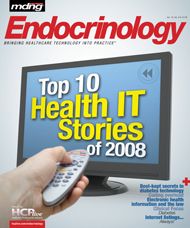Electronic Health Information and the Law What You Need to Know
It is critical to keep exact records and clear communication with patients in order to avoid legal complications.
As the amount of electronic medical information circulating between patients and providers increases, it is critical to keep exact records and clear communication with patients in order to avoid legal complications.
It often appears that laws cannot keep pace with the overwhelming and continuous advancement of medical knowledge. At my legal practice in California, where I represent persons with diabetes, it is apparent that the increasing use of new technology by healthcare providers and patients presents both a remarkable benefit, as well as a potential legal risk. The negative experiences of many healthcare providers lead inevitably to discomfort with the legal process and distrust of its authors and practitioners. However, there are simple solutions to avoid legal complications as new technology is incorporated into medical practices.
MORE INFORMATION
Battery-powered blood glucose (BG) meters frequently have memories that record and maintain BG levels for a given length of time. These records can be downloaded onto a computer and transferred over the Internet from patient to doctor to assist in the review of daily practices and results. Obtaining information in this method is often preferable to the prior practice of reviewing the patient’s paper log of BG results: the provider can have greater trust in the accuracy of the records, and providing the information is easier. While this method of information transfer does not replace reviewing daily logs—which may also include records of other BG factors like exercise, food, and emotional issues—it can help a healthcare provider gain better understanding of a patient’s daily life and allow for improved changes in regimen.
Part of the complication in providing more information to providers is that patients may assume it is being thoroughly reviewed by the healthcare provider. Unfortunately, while the provider may become overwhelmed by all the information being sent to them, the patient may become lazy and assume that the healthcare provider is responsible for daily tasks that the patient had previously completed (eg, “The doctor has my records; he/she will let me know if I’m doing something wrong and need to make a change.”), providing an example of how the seemingly obvious benefit of increased information can have unintended negative consequences.
MORE RESPONSIBILITY
What role does the law play for healthcare providers who do not request or review the transferred records? One could argue that the healthcare provider who makes no effort to consider such records is not taking advantage of opportunities to enhance patient care. As use of these records increases and becomes an accepted practice, it alters the standard of care; failure to utilize such records might be interpreted as malpractice. Although this is arguably not the case today, it is beneficial to develop good habits now.
COMMUNICATION IS KEY
The way to avoid unintended consequences is through direct communication. The role of the patient and the healthcare provider may need to be clarified and restated as the techniques of healthcare change. Healthcare providers and new technology cannot replace the responsibility of the patient, who may need to be reminded of this fact. When problems in BG management become apparent, the patient may need to be reminded with greater emphasis and frequency that the act of simply downloading and transferring BG records does not mean the healthcare provider has reviewed the results and analyzed them sufficiently—nor does it replace patient responsibility for his or her own care. The healthcare provider may need to verify what the patient believes is happening with the records and ensure that all parties involved understand their use and are operating accordingly. Noting the discussion in the chart and confirming it by e-mailing the patient is one way to keep track of the conversation and maintain evidence that the physician and the patient have the same understanding. It is not simply the BG records going from patient to physician that clarify communication and improve care, but information about their meaning and use going back to the patient that complements those efforts and makes them effective. Clear communication and maintaining records of that communication is the key to avoiding complications [legal and medical!] and proving that efforts were made to do so.
Kriss Halpern is a trial attorney practicing in Santa Monica, CA. He has type 1 diabetes, was a volunteer with the Diabetes Control and Complications Trial (DCCT), and frequently lectures with Taking Control of Your Diabetes (TCOYD). Halpern can be contacted through his website.
